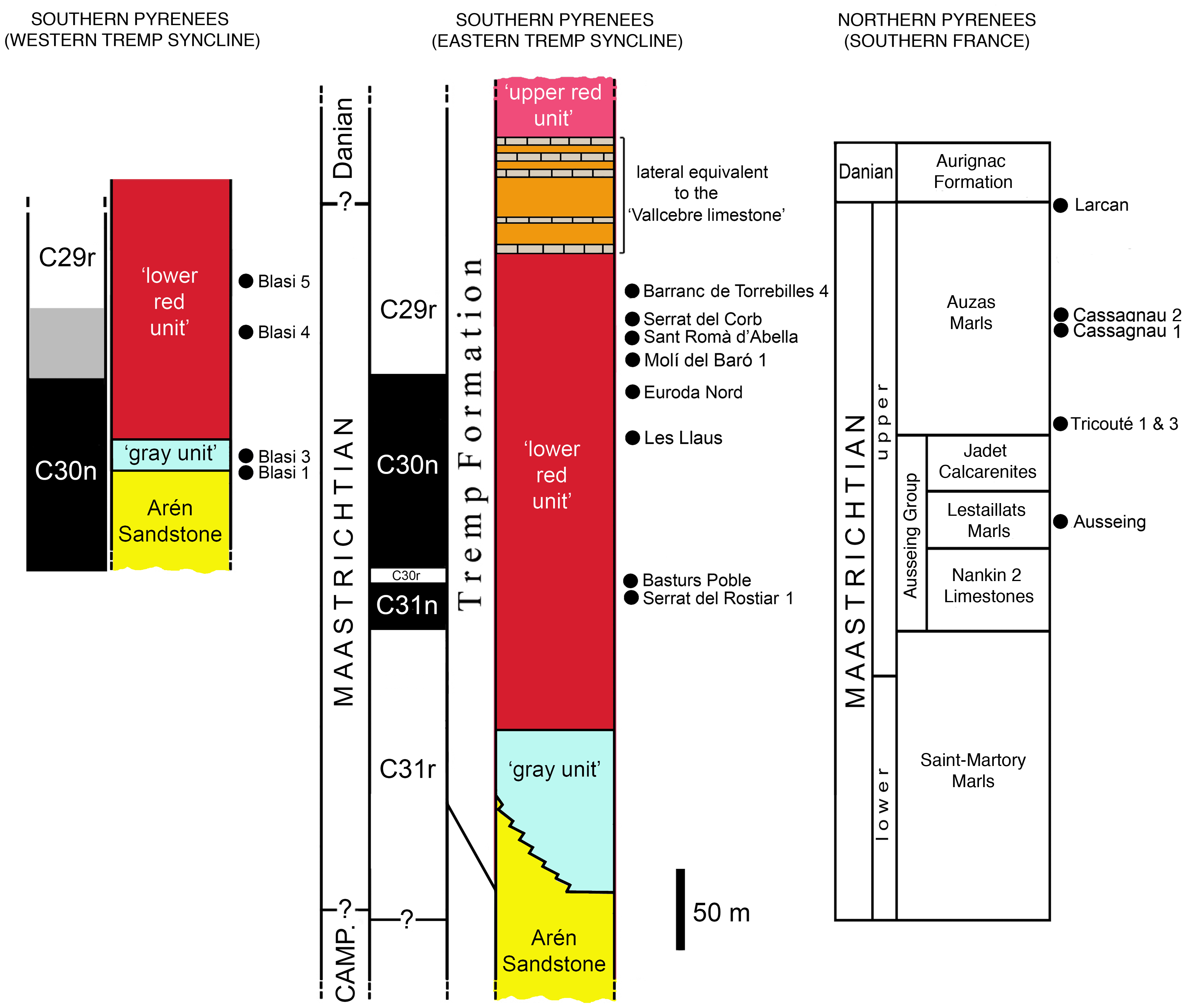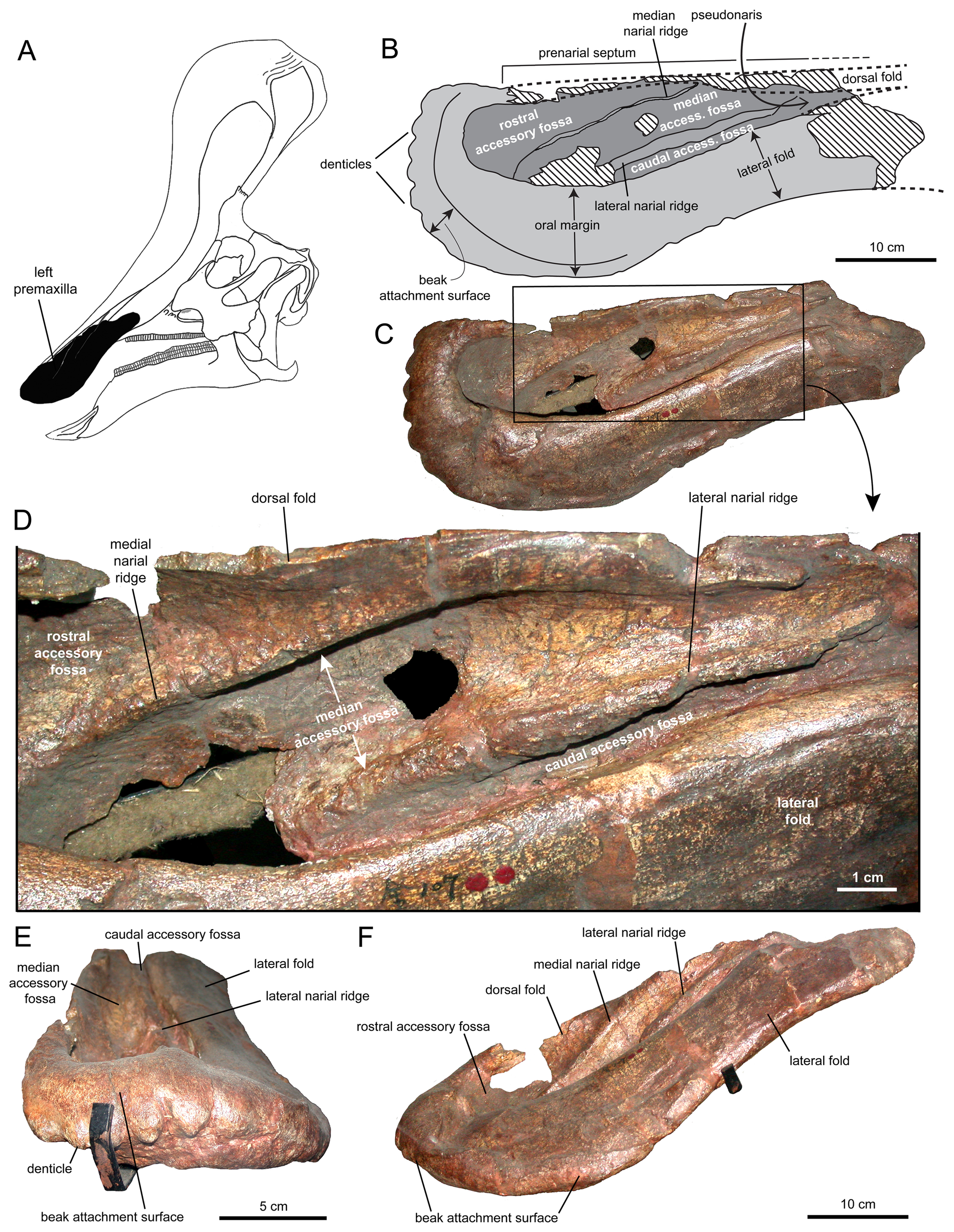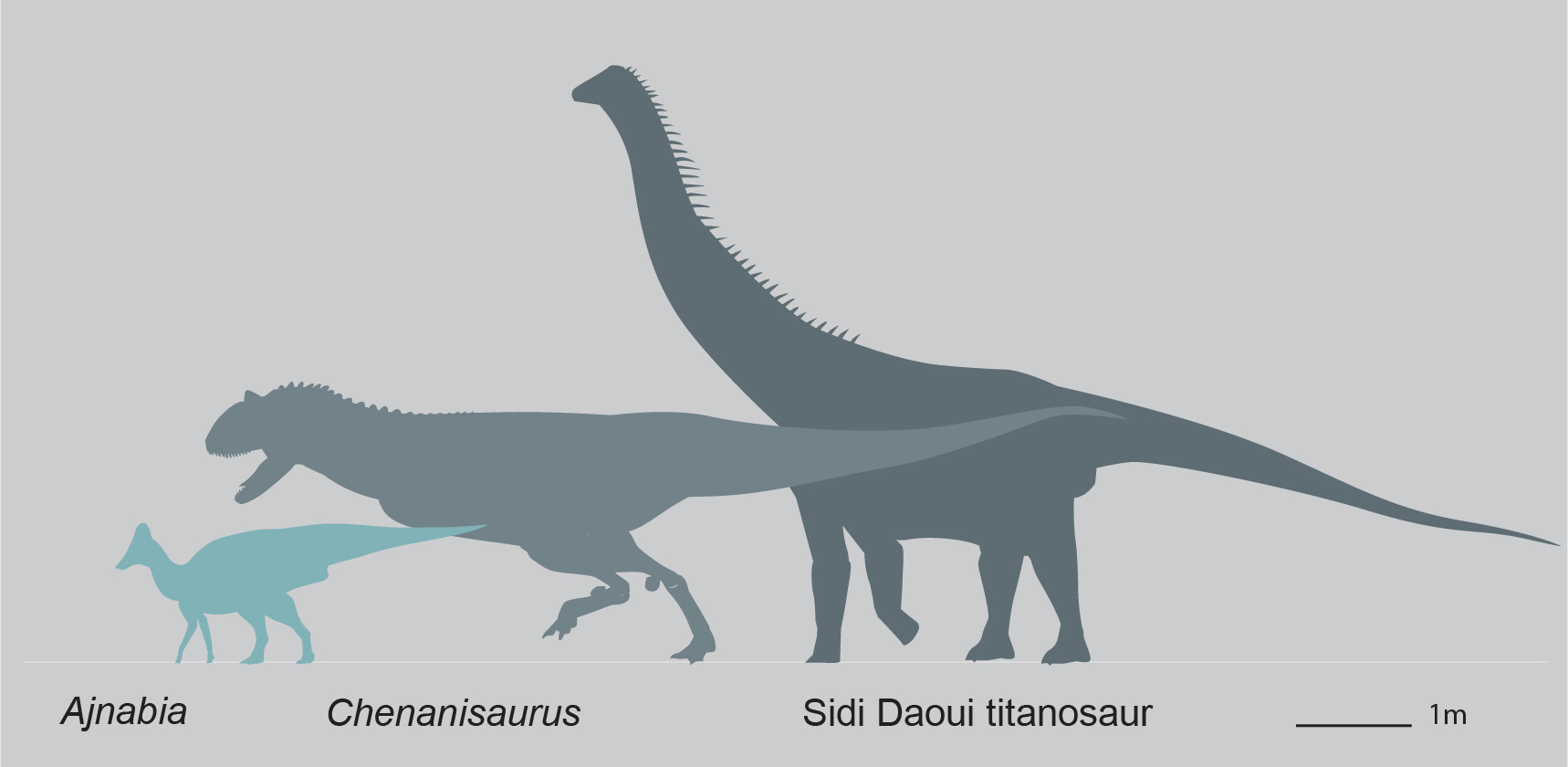|
Koutalisaurus
''Koutalisaurus'' (meaning "spoon lizard", in reference to the shape of the dentary) is a potentially dubious genus of extinct hadrosaurid dinosaur from the Arenysaurini. It is based on a mostly complete dentary from the Maastrichtian-age Upper Cretaceous Tremp Formation near the town of Abella de la Conca, Lleida, Spain. Discovery and naming The holotype dentary, IPS SRA 27, had previously been referred to ''Pararhabdodon'' in 1999,Casanovas, M.L, Pereda-Suberbiola, X., Santafé, J.V., and Weishampel, D.B. (1999). First lambeosaurine hadrosaurid from Europe: palaeobiogeographical implications. ''Geological Magazine'' 136(2):205-211. but comes from a different locality, is based on non-comparable material, and has unusual characteristics, leading Prieto-Marquez ''et al.'' (2006) to place the dentary in the new species ''Koutalisaurus kohleorum''.Prieto-Marquez, A., Gaete, R., Rivas, G., Galobart, Á., and Boada, M. (2006). Hadrosauroid dinosaurs from the Late Cretaceous of Spain ... [...More Info...] [...Related Items...] OR: [Wikipedia] [Google] [Baidu] |
Pararhabdodon
''Pararhabdodon'' (meaning "near fluted tooth" in reference to ''Rhabdodon'') is a genus of tsintaosaurin hadrosaurid dinosaur, from the Maastrichtian-age Upper Cretaceous Tremp Group of Spain. The first remains were discovered from the Sant Romà d’Abella fossil locality and assigned to the genus ''Rhabdodon'', and later named as the distinct species ''Pararhabdodon isonensis'' in 1993. Known material includes assorted postcranial remains, mostly vertebrae, as well as from the skull. Specimens from other sites, including remains from France, a maxilla previously considered the distinct taxon ''Koutalisaurus kohlerorum'', an additional maxilla from another locality, the material assigned to the genera ''Blasisaurus'' and ''Arenysaurus'', and the extensive Basturs Poble bonebed have been considered at different times to belong to the species, but all of these assignments have more recently been questioned. It was one of the last non-avian dinosaurs known from the fossil record th ... [...More Info...] [...Related Items...] OR: [Wikipedia] [Google] [Baidu] |
Basturs Poble Bonebed
The Basturs Poble bonebed is a mega-bonebed of hadrosaur dinosaur fossils, discovered in Catalonia, Spain. Hundreds of hadrosaur fossils have been found at the site, which would have been on a large island during the Late Cretaceous when the animals preserved were alive. Despite the enormous amount of specimens, taxonomically informative material has been scarce at the site, leading to extensive debate as to its nature. The number of species present, age of the individuals present in the sample, and taxonomic identity of the remains have been the primary matters of debate. Previous considered to represent '' Koutalisaurus'', ''Pararhabdodon'', or multiple, perhaps dwarf species, it is currently thought that a single, indeterminate species of lambeosaurine was present at the site, and that individuals of many different ages were present. Discovery and extent Marc Boada discovered, in the late 1990s, a new fossil-bearing locality from the village of Basturs, Catalonia. As the villag ... [...More Info...] [...Related Items...] OR: [Wikipedia] [Google] [Baidu] |
Tremp Formation
The Tremp Formation ( es, Formación de Tremp, ca, Formació de Tremp), alternatively described as Tremp Group ( es, Grupo Tremp), is a geological formation in the comarca Pallars Jussà, Lleida, Spain. The formation is restricted to the Tremp or Tremp-Graus Basin ( ca, Conca de Tremp), a piggyback foreland basin in the Catalonian Pre-Pyrenees. The formation dates to the Maastrichtian to Thanetian,Pujalte & Schmitz, 2005, p.82 thus the formation includes the Cretaceous-Paleogene boundary that has been well studied in the area, using paleomagnetism and carbon and oxygen isotopes. The formation comprises several lithologies, from sandstone, conglomerates and shales to marls, siltstones, limestones and lignite and gypsum beds and ranges between in thickness. The Tremp Formation was deposited in a continental to marginally marine fluvial-lacustrine environment characterized by estuarine to deltaic settings. The Tremp Basin evolved into a sedimentary depression with the break-up ... [...More Info...] [...Related Items...] OR: [Wikipedia] [Google] [Baidu] |
Arenysaurini
Arenysaurini is a proposed tribe of primitive lambeosaurine hadrosaurs. It is composed of genera found in Europe and North Africa during the end of the Cretaceous period, and has been suggested to unite all lambeosaurs from the former continent into a singular monophyletic group. Description Hadrosaurs were a group of herbivorous dinosaurs capable of walking on two or four legs, possessing beaks and complex batteries of teeth; members of Arenysaurini, being of the lambeosaurine lineage of Hadrosauridae, would have possessed large crests on their skulls made up of arrays of nasal passages. Multiple anatomical traits of the skull and teeth unite some or all potential members of Arenysaurini; a mixture of traits seen in primitive and derived lambeosaurs is observed. Examples of primitive traits include a short and a broad dorsal process (bony production) on the maxilla, reduced extensively in derived lambeosaurs. Additionally, several traits distinguish arenysaurs from other lambeos ... [...More Info...] [...Related Items...] OR: [Wikipedia] [Google] [Baidu] |
2006 In Paleontology
Plants Ferns and fern allies Angiosperms Arthropods Insects Tetrapodomorphs Amphibians Newly named temnospondylians Newly named amphibians Ichthyosaurs Lepidosauromorphs Newly named basal lepidosauromorphs Newly named plesiosaurs Newly named squamates Turtles Archosauromorphs Newly named crurotarsans Newly named dinosaurs * Vickaryous, M K., 2006, New information on the cranial anatomy of Edmontonia rugosidens Gilmore, a Late Cretaceous nodosaurid dinosaur from Dinosaur Provincial Park, Alberta: JVP, v. 26, n. 4: 1011–1013. Data are courtesy of George Olshevky's dinosaur genera list. Newly named birds Newly named pterosaurs Synapsids Non-mammalian Mammals Trace fossils * The trace fossil genera ''Nihilichnus'' (''Nihilichnus nihilicus'' and ''Nihilichnus mortalis''), ''Machichnus'' (''Machichnus regularis,'' ''Machichnus multilineatus'', and ''Machichnus bohemicus'') and ''Brutalichnus'' (''Brutalichnus'' ''brutalis'') are described fr ... [...More Info...] [...Related Items...] OR: [Wikipedia] [Google] [Baidu] |
Adynomosaurus
''Adynomosaurus'' is a genus of lambeosaurine dinosaur from the Late Cretaceous of what is now Catalonia, Spain. First discovered in 2012, it was named in 2019 with the type and only species ''Adynomosaurus arcanus'', as an addition to the very incomplete fossil record of hadrosaurides dinosaurs from the Late Cretaceous of Europe. It is only known from scant material, but is distinguished from other hadrosaurs by its weakly developed shoulder blade which would have had underdeveloped musculature, which lends it its scientific name, partially from the Greek word for "weak". Its exact relationships with other hadrosaurs remain unresolved, with it not consistently being recovered as a relative of any other specific genera, though some studies have allied it with Tsintaosaurini or even found it outside of Hadrosauridae. It would have lived as part of a diverse coastal estuaryweak ecosystem, made up of meandering rivers and mud flats, and fits into a picture of major ecological turnove ... [...More Info...] [...Related Items...] OR: [Wikipedia] [Google] [Baidu] |
Canardia
''Canardia'' is an extinct genus of lambeosaurine dinosaur known from the Late Cretaceous Marnes d'Auzas Formation (late Maastrichtian stage) of Haute-Garonne department, in Occitanie region, southwestern France. The type species ''Canardia garonnensis'' was first described and named by Albert Prieto-Márquez, Fabio M. Dalla Vecchia, Rodrigo Gaete and Àngel Galobart in 2013. It is only known from juvenile specimens. The name of the genus comes from “canard”, the French word for “duck”, an allusion to the fact that this animal belongs to the hadrosaurids which are also known as duck-billed dinosaurs. The specific epithet ''garonnensis'' refers to the Haute-Garonne department where this dinosaur has been found. Although universally recognized as a lambeosaurine, its precise position within them is debated. Some authors consider it as a close relative of the genus ''Aralosaurus'' from Central Asia with which it would form the tribe Aralosaurini, while others include it in a m ... [...More Info...] [...Related Items...] OR: [Wikipedia] [Google] [Baidu] |
Tsintaosaurus
''Tsintaosaurus'' (; meaning "Qingdao lizard", after the old transliteration "Tsingtao") is a genus of hadrosaurid dinosaur from China. It was about long and weighed . The type species is ''Tsintaosaurus spinorhinus'', first described by Chinese paleontologist C. C. Young in 1958. A hadrosaur, ''Tsintaosaurus'' had a characteristic 'duck bill' snout and a battery of powerful teeth which it used to chew vegetation. It usually walked on all fours, but could rear up on its hind legs to scout for predators and flee when it spotted one. Like other hadrosaurs, ''Tsintaosaurus'' probably lived in herds. Discovery and naming In 1950, at Hsikou, near Chingkangkou, in Laiyang, Shandong, in the eastern part of China, various remains of large hadrosaurids were uncovered. In 1958 these were described by Chinese paleontologist Yang Zhongjian ("C.C. Young") as the type species ''Tsintaosaurus spinorhinus''. The generic name is derived from the city of Qingdao, earlier often transliterat ... [...More Info...] [...Related Items...] OR: [Wikipedia] [Google] [Baidu] |
Ajnabia
''Ajnabia'' (meaning "stranger" or "foreigner") is a genus of lambeosaurine hadrosaur from the Late Cretaceous (Maastrichtian) of Morocco. It is the first definitive hadrosaur from Africa, and is thought to be related to European dinosaurs like ''Arenysaurus''. The discovery of ''Ajnabia'' came as a surprise to the paleontologists who found it, because Africa was isolated by water from the rest of the world during the Cretaceous, such that hadrosaurs were assumed to have been unable to reach the continent. The animal is relatively small; assuming it represents an adult it would be one of the smallest if not the smallest known hadrosaurids. Discovery and naming Ajnabia was recovered from the Late Maastrichtian strata of the phosphate mines at Sidi Chennane, in Khouribga Province, Morocco. Recovered elements include most of the left maxilla and part of the right, and a fragment of the right dentary. The name Ajnabia derives from the Arabic ''ajnabi'', meaning "stranger" or "foreigne ... [...More Info...] [...Related Items...] OR: [Wikipedia] [Google] [Baidu] |
Blasisaurus
''Blasisaurus'' is a genus of lambeosaurine hadrosaurid dinosaur from the Late Cretaceous. It is known from a partial skull and skeleton found in late Maastrichtian-age rocks of Spain. The type species is ''Blasisaurus canudoi'', described in 2010 by Penélope Cruzado-Caballero, Xabier Pereda-Suberbiola and José Ignacio Ruiz-Omeñaca, a group of researchers from Spain. Naming and discovery The generic name refers to the ''Blasi 1'' site where the fossil was found. The specific epithet honours paleontologist José Ignacio Canudo. The holotype, MPZ99/667, is housed in Huesca. It was found in a layer of the Arén Formation dating from the upper Maastrichtian, about 66 million years ago. It consists of a skull with fragmentary lower jaws. Description ''Blasisaurus'' was a medium-sized ornithopod. Its describers identified two distinct features: the cheekbone has a rear projection with a hook-shaped upper edge and the lower sleep window is narrow and D-shaped. From the same forma ... [...More Info...] [...Related Items...] OR: [Wikipedia] [Google] [Baidu] |
Maastrichtian
The Maastrichtian () is, in the ICS geologic timescale, the latest age (uppermost stage) of the Late Cretaceous Epoch or Upper Cretaceous Series, the Cretaceous Period or System, and of the Mesozoic Era or Erathem. It spanned the interval from . The Maastrichtian was preceded by the Campanian and succeeded by the Danian (part of the Paleogene and Paleocene). The Cretaceous–Paleogene extinction event (formerly known as the Cretaceous–Tertiary extinction event) occurred at the end of this age. In this mass extinction, many commonly recognized groups such as non-avian dinosaurs, plesiosaurs and mosasaurs, as well as many other lesser-known groups, died out. The cause of the extinction is most commonly linked to an asteroid about wide colliding with Earth, ending the Cretaceous. Stratigraphic definitions Definition The Maastrichtian was introduced into scientific literature by Belgian geologist André Hubert Dumont in 1849, after studying rock strata of the Chalk Group c ... [...More Info...] [...Related Items...] OR: [Wikipedia] [Google] [Baidu] |
Nomen Dubium
In binomial nomenclature, a ''nomen dubium'' (Latin for "doubtful name", plural ''nomina dubia'') is a scientific name that is of unknown or doubtful application. Zoology In case of a ''nomen dubium'' it may be impossible to determine whether a specimen belongs to that group or not. This may happen if the original type series (i. e. holotype, isotype, syntype or paratype) is lost or destroyed. The zoological and botanical codes allow for a new type specimen, or neotype, to be chosen in this case. A name may also be considered a ''nomen dubium'' if its name-bearing type is fragmentary or lacking important diagnostic features (this is often the case for species known only as fossils). To preserve stability of names, the ''International Code of Zoological Nomenclature'' allows a new type specimen, or neotype, to be chosen for a ''nomen dubium'' in this case. 75.5. Replacement of unidentifiable name-bearing type by a neotype. When an author considers that the taxonomic identity of a ... [...More Info...] [...Related Items...] OR: [Wikipedia] [Google] [Baidu] |








